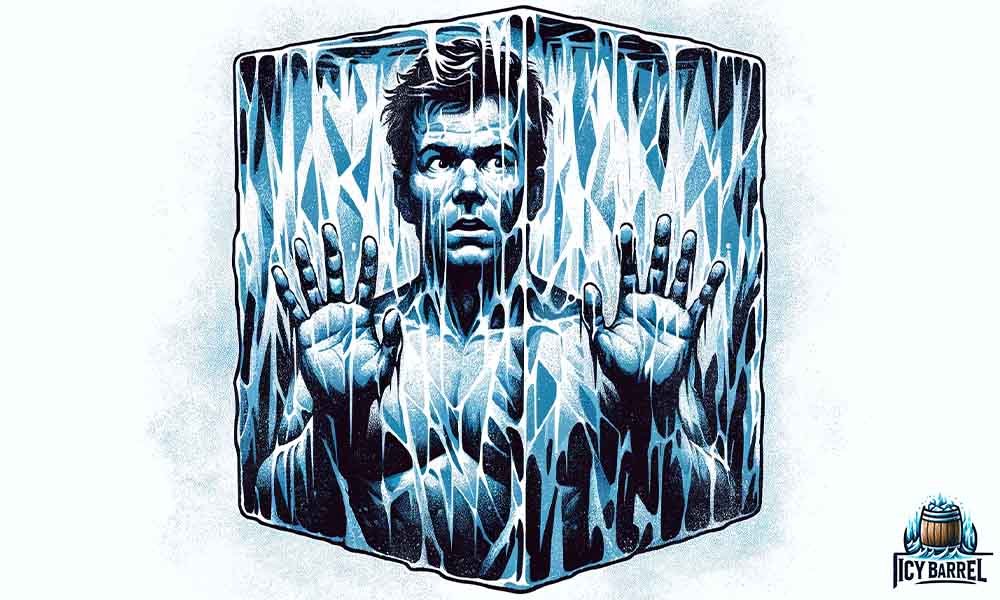Ice baths might be trending as a cool-down ritual among athletes and wellness enthusiasts, but they’re not all chill and relief. In fact, diving into frigid waters without proper precautions can send shivers down your spine for all the wrong reasons. You’ll want to stay tuned as we unveil the hidden dangers lurking beneath the ice.
From the numbing shock of hypothermia to the deceptive “after drop,” taking the plunge is no simple dip in the pool. And if you’re considering using that old chest freezer, think again—electrocution is a real threat. So before you take the icy plunge, let’s explore why ice baths may be a slippery slope to your well-being.
Are Ice Baths Dangerous?
Understanding the risks before taking a dip into icy waters is key to your safety. While many swear by the rejuvenating effects of ice baths, potential hazards lurk that need to be assessed.
Hypothermia
When you plunge into an ice bath, you expose yourself to temperatures that can be shockingly low, often between 50 and 59 degrees F. The National Institute for Occupational Safety and Health warns that water saps heat from your body 25 times faster than air. hypothermia occurs when your body temperature falls below 95 degrees F. It can begin to set in after just a few minutes in cold water, manifesting through shivering, slurred speech, and shallow breathing. Extended exposure can lead to severe complications, even death. Keep each session brief and be particularly vigilant if the water is below 70 degrees—a temperature significantly higher than typical ice bath temperatures yet still in the danger zone.
Cardiac Arrest
There’s a hidden danger in the chilling effect of an ice bath on your heart. Tipton and colleagues found that cold shock can trigger a gasp reflex while breath-holding may initiate a dive reflex. This conflict between opposing autonomic responses may cause Cardiac Arrest—an unexpected and silent killer. Autonomic conflict from rapid immersion into cold waters can dangerously disrupt your natural heart rhythm. Being aware of this risk is crucial, especially if you’re new to cold water immersion therapies.

Afterdrop
“Afterdrop” describes the continued cooling of your core temperature after you’ve exited the water. This counterintuitive effect can result in cognitive and attentive impairment, making activities like driving, hazardous post-immersion. It’s not just the cold water you need to worry about—it’s the after effects too. Your body might be more vulnerable during rewarming than you realize, so plan your recovery time accordingly.
Psychophysiology
The body’s response to cold water doesn’t end at the physical. The psychological impact of experiencing intense cold can be significant. Cold water immersion can confuse your body’s signals, leading to disorientation and panic—psychophysiological responses you might not anticipate. If you’re not properly prepared or supervised, such reactions could increase your risk of drowning or other accidents. Respect the power of cold on your mind and body.
Drowning
drowning is a very real threat in any water-based activity, but the stakes are higher with ice baths. The initial shock of cold water can provoke a cold shock response, a potentially fatal cocktail of rapid heart rate, hyperventilation, and high blood pressure, all increasing the danger of involuntary water intake and subsequent drowning. Especially in unsupervised situations or if you’re not a confident swimmer, the risks amplify. Remember to always prioritize safety by having someone with you and knowing your own limits in the water.
Best Cold Therapy Protocols

When diving into the world of cold therapy, adhering to established protocols is essential for maximizing benefits while staying safe. Studies show that specific temperatures and timeframes can enhance recovery without exposing you to unnecessary danger. Let’s delve into the protocols recommended by experts.
The Right Temperature
Temperature regulation is paramount. Aim for a water temperature between 50°F (10°C) and 59°F (15°C) for optimal results. At these temperatures, you’ll experience the therapeutic shiver without the immediate threat of hypothermia. It’s the goldilocks zone — cold enough to stimulate your body’s recovery mechanisms but not so cold that risks escalate.
Timing Your Exposure
Duration also plays a critical role. Limit your sessions to an appropriate length, rooted in scientific research — about 11 minutes per week, spread over three to four sessions. This practice helps to achieve the desired effects while steering clear of threats like the “afterdrop”.
Safe Practice
Listen to your body and respect your personal tolerance. Starting slow and gradually increasing your exposure can help acclimate your system. Remember, overexposure won’t enhance benefits but will elevate risks. And always have a plan for rewarming, allowing your body to naturally recalibrate its core temperature.
Consistency Over Intensity
Consistency in your cold therapy practice beats intensity. Regular, moderate exposure supports pain reduction and minimizes dependence on medication. Topical applications should follow a 20 minutes on, 20 minutes off cycle to reduce swelling without compromising tissue integrity.
Research comparing cold water immersion to whole-body cryotherapy suggests both methods can be effective; however, choose the method that best fits your comfort and resources. Whether it’s a chilled bath post-exercise or a brief cryotherapy session, aligning your practice with these guidelines will support a safe and beneficial recovery regimen. Remember to consider individual variables like health status and physical condition when tailoring your cold therapy protocol.
What Are the Potential Benefits of an Ice Bath?

As you dive into the chilly waters of an ice bath, it’s essential to recognize the potential advantages this practice can offer. Beyond the familiar use in sports for rapid recovery, the benefits of ice baths are gaining traction for its holistic health advantages.
Managing Stress is one area where ice baths show promise. The shock of cold water can trigger hormonal responses that may reduce stress levels, leading to an improved mood and a sense of relaxation. This cold-induced stress, paradoxically, helps your body to better manage everyday stressors.
Another area under scientific scrutiny is the link between ice baths and mental health, particularly in regards to depression. Some researchers suggest a connection between regular cold exposure and alleviation of depressive symptoms, although this is still to be conclusively proven. The feeling of invigoration after an ice bath could play a role in why participants report feeling uplifted.
Physical discomfort, be it from an intense workout or an underlying joint issue, may also be alleviated through ice baths. CWI has shown potential in shortening recovery periods and lowering pain levels in the body. Athletes have long utilized ice baths to mitigate muscle soreness and facilitate quicker returns to training.
While the jury is still out on the full spectrum of health improvements, interest in the practice continues to grow. It’s essential to remember that the perceived benefits of ice baths can be subjective, and what works for some may not work for others. Some studies indicate that the positive effects could partially be a placebo effect, a psychological phenomenon where you experience benefits simply because you believe the treatment will help.
Before you schedule your next ice bath session, it’s wise to consider how it fits into your overall healthcare routine. Personal factors like medical history and current health status play critical roles in determining if ice baths are suitable for you. Always consult with a healthcare professional to weigh the potential benefits against any risks, ensuring that your approach to cold therapy is both safe and effective.
Conclusion
You’ve explored the ins and outs of ice baths, weighing the potential for rapid recovery against the need for caution. Remember, your body’s response is unique, and what works for others may not be ideal for you. Always listen to your body and seek advice from a healthcare professional to ensure ice baths are a safe addition to your regimen. Embrace the journey to well-being, but do so with informed decisions and a mindful approach to new health practices.
Frequently Asked Questions
How long is it safe to stay in an ice bath?
Try to stay in the ice bath for as long as you can but do not exceed 15 minutes. It is recommended to work up to the recommended 15 minutes without pushing your body beyond its limits.
Can bacteria grow in ice bath?
Yes, bacteria can develop in an ice bath if the water does not maintain sufficient cleanliness and hygiene. The longer the water is used, the greater the risk of bacterial growth and contamination.
Is it OK to cold plunge every day?
No, it is not recommended to cold plunge every day. More cold plunging is not necessarily better. Exceeding 11 minutes per week of deliberate cold exposure can harm your health.
Is cold plunge bad for your heart?
While more research is needed, cold plunging can lead to hypothermia, raise stress hormone levels, and increase the risk of abnormal heart rhythms (arrhythmias), possibly even cardiac arrest.
Who shouldn’t do cold plunges?
People who are hypertensive, have an aneurysm, cardiovascular disease, or are susceptible to the cold shock response should not do cold plunges. Hands and feet are especially vulnerable, and cold plunges should not last for more than 10 minutes.




